Herons, Bitterns, and Egrets
Order: Ciconiiformes
Family: Ardeidae
Ciconiiformes is the order of birds that includes 1027 species of storks, ibises, and other similar birds. Of the 29 families in the order Ciconiiformes, Ardeidae is one (Gordon). This family of birds includes herons, bitterns, and egrets. Herons, bitterns, and egrets are typically long-necked wading birds that inhabit marshes and wetlands, hunting in shallow waters and nesting in the vegetation and trees near water. Their proportions – long bills, long S-shaped necks, and long legs – make them suited for living in and foraging in this environment. These gregarious birds share a common habitat, often living in colonies and breeding communally (Gordon).
Birds of this family tend to be passive in catching its prey, waiting for the prey to come to them rather than pursuing. There are 28 recognized heron foraging behaviors, including standing in place waiting for prey to approach or slowly wading through the water. They also sway their neck, which dulls glare, improves depth perception, and keeps their muscles moving to ensure a quick reaction when they see prey (Poole).
Video of heron hunting:
Some herons and their allies grow plumages, or extra long feathers that extend from the back of the head or tail, during breeding season to attract mates. In the early 20th century, some of these birds were actively hunted to near extinction for their beautiful plumages. Currently, the IUCN Conservation status of herons, bitterns, and egrets are of “least concern,” meaning they are not endangered. However, a prominent issue with these wading birds that are heavily dependent on water is acid precipitation that affects the ecosystems and thus the food supply of these birds (Poole).
The birds of the family Ardeidae that will be discussed are herons, bitterns, and egrets of Missouri. The common name is the name that is used regularly, and the scientific name is made up of two parts, the first being the genus and the second being the species.
When identifying birds, key clues to look for are color, size, shape and color of bill, habitat, food, and body posture. Below is a basic field guide for identifying the herons, bitterns, and egrets found in Missouri. Noted for each species are some of these key identification factors as well as illustrations.
Herons
Black-crowned night heron (Nycticorax nycticorax)

original artwork by Michelle Kim
The black-crowned night heron has its name because black feathers circle its head like a crown and it is active at dawn and dusk. This bird, 22 to 27 inches long (56 to 69 cm), is recognized for being an anomaly of its family. It is uncharacteristically stocky and short-necked and hunts alone. Its noticeable visual characteristics are a black back and crown, long dark bill, yellow legs, bright red eyes, 2 long white plumes on its crown during breeding season. Its diet consists of fish and aquatic insects. Black-crowned night herons nest in colonies and roost in trees during the day.
Great blue heron (Ardea herodias)
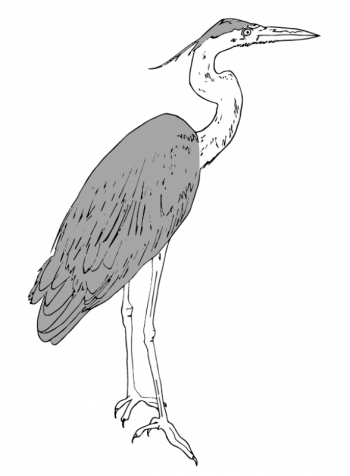
original artwork by Michelle Kim
The great blue heron, 42 to 52 inches long (107 to 132 cm), is grey with black eyebrows that become plumes at the back of the head. It has a large yellow bill and a feathery “necklace” at the base of the neck. Its diet consists of small fish, frogs, and snakes. The great blue heron is one of the most common herons and also the largest darkest heron. It is often seen preying in water and nesting in trees near bodies of water in colonies. The great blue heron possesses the unique ability to bark like a dog when startled (Tekiela).
Green heron (Butorides virescens)

original artwork by Michelle Kim
This beautiful blue-green bird, 16 to 22 inches (40 to 56 cm), is somewhat unlike the birds of its family: it has a short-necked and stocky body, has a green back and crest, and a rusty-red neck and chest. The yellow legs turn bright orange during breeding season to attract mates. The green heron, like other herons, eats fish, insects, and aquatic plants. When it hunts, it waits stealthily around the water rather than approaching its prey, sometimes even placing an insect on the surface of water to attract fish (Tekiela).
Little blue heron (Egretta caerulea)

original artwork by Michelle Kim
The little blue heron, 22 to 29 inches (56 to 74 cm), is actually only blue when mature. Juveniles have white bodies and plumages that become slate blue. During the transition from immature to adult, they are called Calico, Pied, or Piebald herons. The little blue heron’s head and neck are a reddish brown, and the tip of its bill is black. Its diet consists of small fish (like anchovies and darters), amphibians, invertebrates (like crustaceans), frogs, and grasshoppers. They live in a variety of freshwater and marine-estuarine habitats. Its dark plumage helped it to escape the plumage hunting of the early 20th century, but they now face food scarcity, pesticides, and other contaminants. The little blue heron population count is relatively low, and the premature deaths from starvation implicate that the low numbers are attributed to food limitation (Poole).
Yellow-crowned night heron (Nyctanassa violacea)
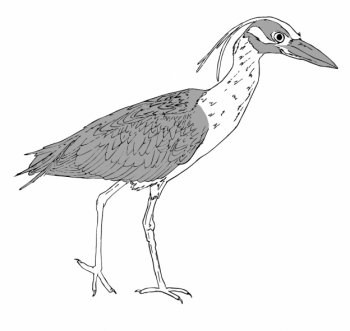
original artwork by Michelle Kim
The yellow-crowned night heron, 28 inches (71 cm), lives in freshwater ponds, sloughs, and lagoons. It actually does most of its feeding during the day and not night. It is a less common heron and is solitary, unlike other herons. It has a blue-grey body, a yellow crown with plumes at the back of the head during breeding times, a black head with white lines below and behind the eye, bright red eyes, and yellow legs and feet. Its diet is unlike other herons, which usually consists of fish. The yellow-crowned night heron eats small crabs, crayfish, snails, small snakes, lizards, leeches, and mice (Rue III).
Bitterns
American bittern (Botaurus lentiginosus)

original artwork by Michelle Kim
The American bittern stands 24 to 30 inches (60 to 85 cm) tall, with a stout body and neck. Its pale brown body and plumage and striped colorations allows it to camouflage in the vegetation around the wetlands it inhabits. The adult plumage is all brown above and white below, with a brown crown, patch of black below the eye, and white neck. Its diet consists of insects such as waterbugs, water beetles, dragonflies, grasshoppers, amphibians, crayfish, small fish like eels, catfish, sunfish, and small mammals. The American bittern hunts during crepuscular hours, capturing passing prey by waiting patiently. It is known to use only 4 of 28 recognized heron foraging behaviors: neck swaying, standing in place, walking slowly, and walking quickly. It is nicknamed the “thunder-pumper” or “mire-drum” among scientists for its use of resounding calls to communicate to nearby habitats. Yet, the American bittern tends to be secretive and solitary, rarely perching in trees like other birds of its family (Poole).
Least bittern (Ixobrychus exilis)

original artwork by Michelle Kim
The least bittern is the smallest of the heron family, standing at 11 to 14 inches (28 to 36 cm). It is brown and white on its undersides, neck, sides, and wings. The back, crown, and tail are a greenish black for males and purple for females. Its diet consists of small fish including top minnows, sunfishes, perches, frogs, tadpoles, salamanders, crayfish, insects like dragonflies, small mammals like mice, and vegetable matter. They wade in fresh and brackish water marshes with dense vegetation that they can easily move through because of their small size. They grab onto the vegetation with their feet to walk, sometimes walk along the water, or burrow into the ground like rodents. Its foraging behaviors include neck swaying, standing in place, wing flicking (to startle prey from hiding), and walking quickly (Poole).
Egrets
Cattle egret (Bubulcus ibis)
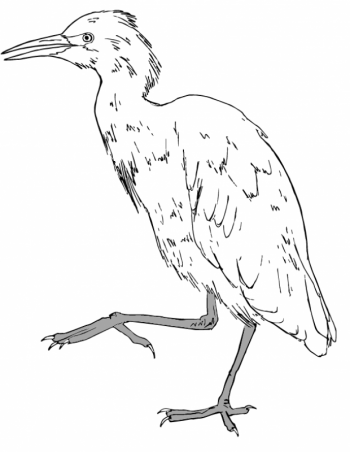
original artwork by Michelle Kim
The cattle egret is the most gregarious and territorial of all herons, foraging close to grazing cattle or other livestock and even in urbanized areas. Its size is 17 to 20 inches (43 to 50 cm), and it is stocky with a thick neck and large head. Its body and plumage is white with an orange crest, breast, and back and yellow bill and dark legs. It eats mostly insects like grasshoppers and crickets, small mammals, wolf and ground spiders, frogs, moths, ticks, crayfish, mayflies, cicadas, and centipedes. It is least passive in its hunting, stabbing the prey with its bill and throwing it into its mouth swiftly. It lives in a variety of habitats, from aquatic environments to cow and horse pies (Poole).
Great egret (Ardea alba)

original artwork by Michelle Kim
The great egret is very tall, standing at 38 inches (96 cm) with its slim white body and thin black legs. Fish, aquatic insects, frogs, and crayfish are its typical prey. It slowly walks on shallow wetlands,
hunting small fish with its long, sharp, yellow bill. Being one of the most elegant birds, it was hunted to near extinction in the 1800s and early 1900s for its long white plumage that extends from its tail during breeding season. Its name, egret, comes from the French word aigrette meaning ornamental tufts of plumes.
Snowy egret (Egretta thula)
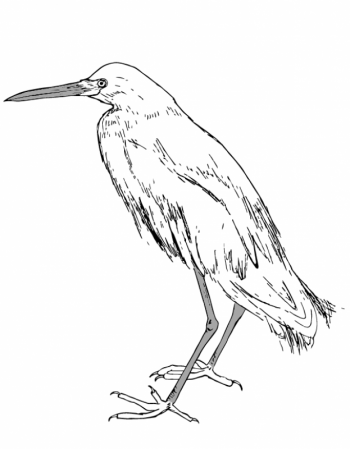
original artwork by Michelle Kim
The snowy egret is all white, as its name suggests, with a black bill and legs and yellow feet. It stands 24 to 28 inches (60 to 71 cm), with long plumes going down the entire back during breeding season. A patch below the bill and the feet turn red-orange during breeding season as well. It eats what all herons commonly eat, aquatic insects and fish, and live in wetlands in large colonies that are made of hundreds of nests. The snowy egret moves quickly when hunting prey. Predictably, it was also hunted to for its beautiful white feathers in late 1800s.
Field Guide
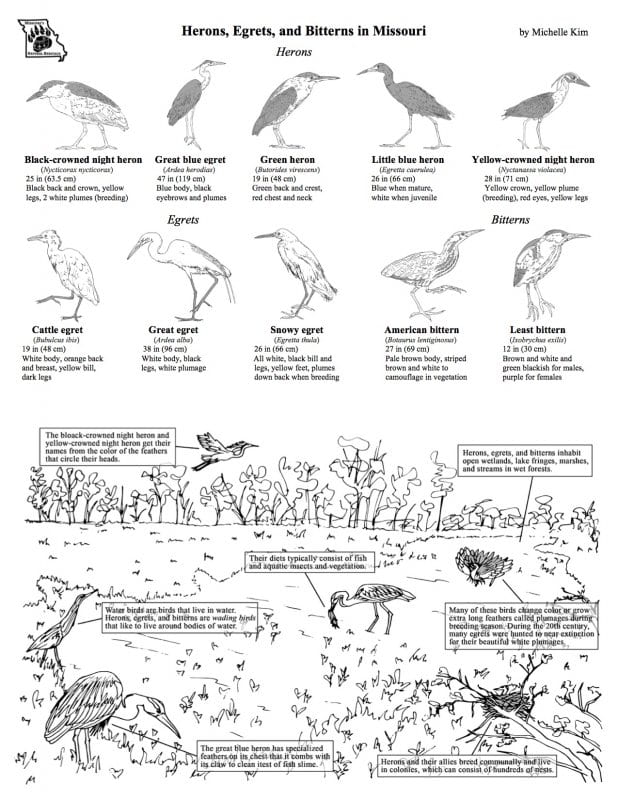
This page was written and created by Michelle Kim
Works Cited
Khoon, Foo Sai. “Hunting Techniques of Great-Billed Heron.” Bird Ecology Study Group, National University of Singapore: Lee Cong Chian Natural History Museum. <http://www.besgroup.org>. Web. 6 October 2017.
Liner, Eric S., director. Great Blue Heron hunting. YouTube, Cornell Lab of Ornithology, 5 June 2015. <www.youtube.com>. 6 October 2017.
Poole, Alan, F., et. al. (Ed). The Birds of North America. Philadelphia, PA: The American Ornithologists’ Union and Union NS The Academy of Natural Sciences of Philadelphia, 1992.
Ramel, Gordon. “The Ciconiiformes.” <www.earthlife.net>. Web. 10 Dec. 2016.
Rue III, Leonard Lee. Pictorial Guide to the Birds of North America. New York: Thomas Y. Crowell Company, 1970.
Tekiela, Stan. Birds of Missouri Field Guide. Cambridge, MN: Adventure Publications, Inc., 2001. Print.